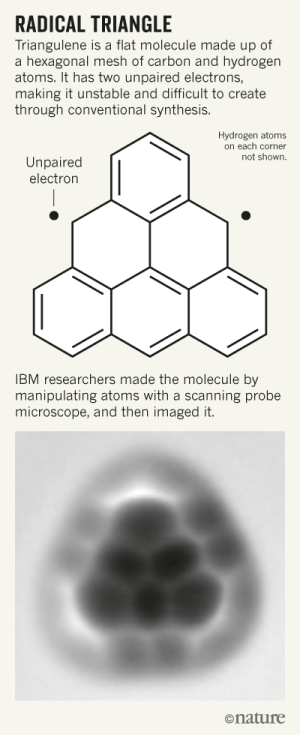This is truly a great age of material science!
As I have always said, if I can manipulate individual atoms, I can perform Black Magic!
This month IBM researchers have published the synthesis of “Triangulene”, an impossible triangular molecule [2]. Cool!
Triangulene was first hypothesized more than fifty years ago, but “has been an enigmatic molecule ever since its existence was first hypothesized.” ([2], p.1) The molecule is extremely unstable and has evaded attempts to synthesize it until now.
“The new molecule is made up of six hexagons of carbon joined along their edges to form a triangle, with hydrogen atoms around the sides.” ([1], p.284)
 from: http://www.nature.com/news/elusive-triangulene-created-by-moving-atoms-one-at-a-time-1.21462
from: http://www.nature.com/news/elusive-triangulene-created-by-moving-atoms-one-at-a-time-1.21462
The IBM team created the molecule through direct manipulation of the atoms with a Scanning Probe Microscope, basically, “knocking around atoms using a needle-like microscope tip.” ([1], 284) As far as I’m concerned, this constitutes “a lever and a place to stand”.
(We’ve been dreaming about this sort of thing for a long time, since Feynman (1959!) and in science fiction)
The details of this sorcery are far beyond my own knowledge. I barely scraped through basic Chem class not long after Triangulene was hypothesized, so I’m not really sure of all the implications.
But, hey! It’s called “Triangulene“! Just look at it! It’s awesome!
Some have expressed reservations that making one atom at a time “by hand” is impractical, unlikely to scale up.
“But making molecules one at a time will be useful only in particular situations. And the method is unlikely to work for those with complicated shapes or structures that make it hard to identify or target individual atoms.” ([1], 284)
Coming from the world of digital technology, I think these fears are overly pessimistic. If there is a reason to scale this up, I will bet you we can build programmable robots that automate and speed up the process, and probably extend it to 3D (just like we extended 2D printing to 3D). Such a a development will lead to software libraries and CAD systems for designing and then printing molecules.
Simply awesome!
Share this:
- More






